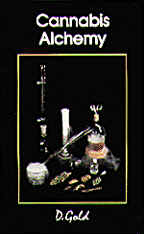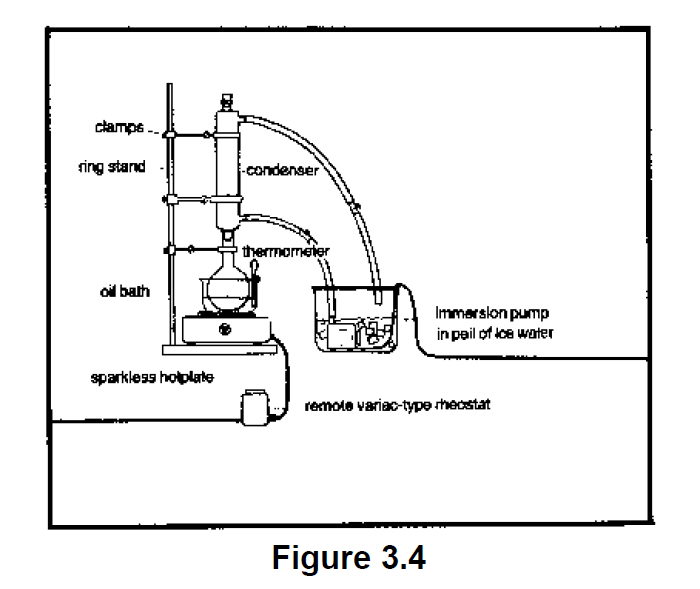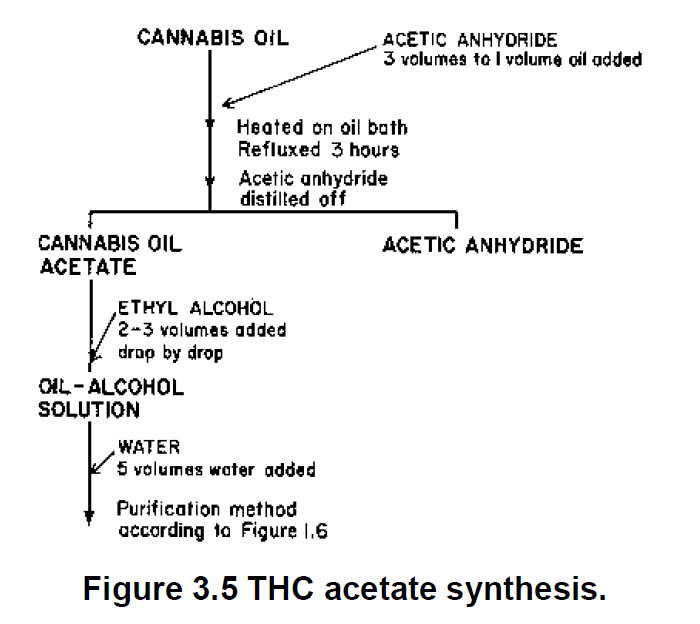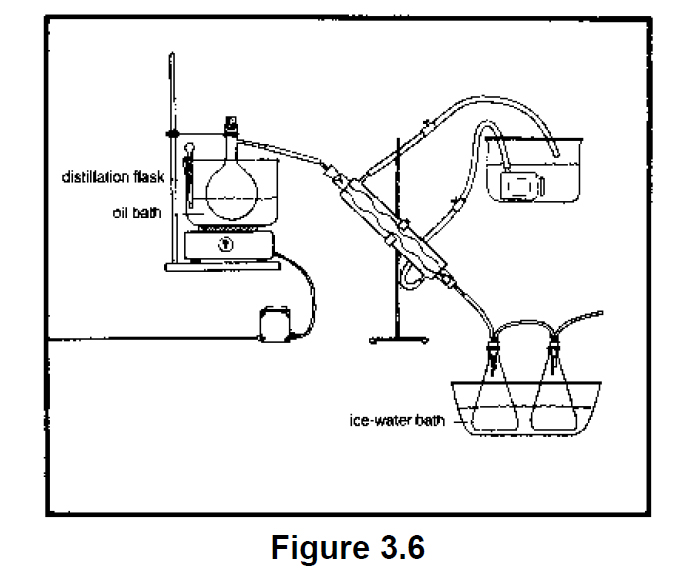
Cannabis Alchemy
by D.Gold
Conversion of THC to its acetate
THC is converted to THC acetate by refluxing for two hours with acetic anhydride. The following apparatus is assembled as illustrated in the diagram:
- 500 ml Pyrex round-bottom boiling flask with a ground glass fitting.
- Tubular type condenser with ground glass male fitting that matches the fitting on the boiling flask.
- Metal pot of at least 2000 ml as hot oil bath for heating boiling flask.
- Thermometer for monitoring the oil bath temperature.
- Sparkless electric hotplate.
- Rheostat to control temperature of hotplate from outside the box.
- Ring stand and proper clamps for securing flask and condenser.
- Cottonseed oil.
- Acetic anhydride.
- Immersible water pump, bucket, and hoses for filling condenser.

The principle of the refluxing operation is approximately the same as was used for isomerizing the cannabidiol to THC with the kitchen apparatus. The explosive and noxious nature of the acetic anhydride necessitates the use of the safety box. Although a glove box is unnecessary for the operations of extraction and isomerization using the kitchen method previously described, these steps may also be done in the box as an added measure of safety. The solution of acetic anhydride and cannabis oil is boiled in the round-bottom flask. The fumes rise into the icewatercooled condenser, where they are condensed back into liquid, thus relieving the pressure created by boiling. The drops then fall back into the solution.
Before assembling the apparatus, these factors are taken into account: the temperature of the hotplate must be controlled from the outside of the box. This necessitates a variac-type rheostat in the power line to the hotplate. The pail containing the immersion pump which circulates the icewater coolant through the condenser should also be outside the box. There are two small holes in the safety box for the icewater input and return hoses. Although the sink at the left station of the box seems handy for the coolant pump, this would necessitate opening the side panel while the refluxing is in progress to add ice and remove water. The equipment is assembled and operated in this manner: the right side panel is opened, and at station one the boiling flask, condenser, oil bath, and hotplate are assembled as illustrated in Figures 3.1 and 3.2. Each item is secured to the ring stand with adequate clamps. The flask is positioned at least one-half inch above the bottom of the oil bath. Electrical connections are not made nor the coolanthoses attached to the condenser yet, as the entire apparatus will be moved over to the center station before beginning. The boiling flask, prior to being put in the safety box, contains a measured amount of cannabis extract. In the safety box are also placed the following: an unopened bottle of acetic anhydride, an empty graduated beaker, a beaker containing sufficient cottonseed oil to fill the oil bath to a level slightly above that of the cannabis oil/acetic anhydride solution that will be in the flask, and an empty, open-top container of the same height as the boiling flask and of a slightly larger diameter. This container holds the boiling flask safely when the apparatus is dismantled. The clamps holding the condenser are loosened and slid up the ring stand so that the mouth of the boiling flask is accessible for addition of the acetic anhydride. The right side panel is closed and the chamber is filled with nitrogen; then, using the gloves through the front board at station one, the bottle of acetic anhydride is opened. An amount is poured into the graduated beaker equal to three times the volume of the cannabis oil in the boiling flask. The cap on the acetic anhydride bottle is replaced and the acetic anhydride is poured carefully from the graduated beaker into the boiling flask. The condenser is securely replaced on the boiling flask and a solid rubber stopper is loosely fit to the top of the condenser. The side panel is opened and the apparatus is moved to the center station. The input icewater hose is connected to the lower fitting of the condenser. The return hose runs from the uppermost fitting (assuring that the condenser is always filled with circulating water) through a hole in the safety box to a pail containing the icewater and immersion pump. The fittings are secured onto the condenser with twisted wire or automobile-type hose clamps. The power wire for the hotplate is also run through a hole in the safety box and connected to the rheostat. The oil bath temperature is monitored with a thermometer, which is adjusted for observation through the safety glass window. The cottonseed oil is added to the bath. The empty beaker and the closed bottle of acetic anhydride are removed. The side panel is closed and secured. More nitrogen is now bled into the box until the air has been completely replaced by nitrogen. Striking a match is not a good idea for a test at this time, but if the test is tried a few times prior to beginning the operation, the time it takes to drive out the air completely can be estimated. The pail containing the immersion pump is filled with water and ice, the pump is turned on, and the condenser is filled with circulating icewater. The oil in the oil bath is heated by turning on the electric hotplate. The temperature is raised slowly (indicated on the thermometer), giving the solution in the flask time to heat the temperature of the bath. The temperature is noted at which the solution of cannabis oil and acetic anhydride begins to fume and droplets of pure acetic anhydride form in the condenser and fall back into the solution. The temperature is slightly raised until the solution in the flask begins to boil. The bath temperature is stabilized at this point. This is continued for three hours. Ice is supplied as needed to the container with the immersion pump.

After three hours of refluxing, the electricity to the hotplate is turned off and the solution is allowed to cool to room temperature. Ice water is kept circulating through the condenser. After the solution has remained at room temperature for at least two hours, the rubber stopper at the top of the condenser is checked. It should form a perfect seal, but not be too tightly jammed into the condenser. The immersion pump is then turned off and the apparatus is allowed to sit at room temperature for another hour. At the end of this time the clamps holding the condenser are loosened and slid at the ring stand as before, giving access to the aperture of the boiling flask. The rubber stopper is removed from the top of the condenser and fitted tightly in the top of the boiling flask. The clamp holding the boiling flask is loosened and the flask is removed from the oil bath. The flask is wiped clean of oil and set into the empty open-top container set in the box earlier. The side panels are opened and the equipment is dismantled. Removing the acetic anhydride by distillation is the next step (see Figure 3.6). The distillation requires the following equipment not used for refluxing:
- A Pyrex distillation flask of the same capacity as the boiling flask, and two Erlenmeyer flasks, also of the same capacity.
- An assortment of glass tubing, flexible tubing, and rubber stoppers.
- A large pan to be used as an icewater bath for the Erlenmeyer flasks.
- Several more ring stands and equipment clamps.
As the solution in the distillation flask is heated, the acetic anhydride vaporizes; the fumes rise and travel down the side arm of the distillation flask into the condenser, where they are cooled to liquid. The recondensed acetic anhydride is collected in the receiving flask at the end of the condenser. This flask and a back-up flask used for safety are immersed in an ice water bath.

The equipment is assembled at stations one and two as illustrated in Figure 3.6. The condenser is at a great enough angle that no acetic anhydride can lie between the condenser bottom and the exit tube. The glass tube for the introduction of the recondensed acetic anhydride extends deeper into the flask than the exit tube. The same is true of the back-up flask, even though it is unlikely that any fumes or liquid will go beyond the first flask. The tube leading from the backup flask is open at the end.
The side panel is closed, the atmosphere is replaced with nitrogen gas as before, and the following process is used: using the gloves, the cannabis oil/acetic anhydride solution is poured from the boiling flask into the distillation flask. A funnel with a tube long enough to extend past the side arm of the distillation flask is used. This eliminates the chance of any solution running into the condenser. The rubber stopper is secured to seal the top of the distillation flask. The cottonseed oil is added to the oil bath, and the ice and water to the ice bath. The immersion pump and the hotplate are turned on. The temperature indicated by the thermometer in the oil bath is raised slowly to that used for the refluxing. This temperature is maintained until no more acetic anhydride is evaporated and collected. The volume of cannabis oil acetate now in the distillation flask will be up to twenty-five per cent more than the volume of the oil prior to acetylation. The oil temperature is maintained for one hour after the last traces of acetic anhydride have been removed. The hotplate is turned off, and, with the water still circulating through the condenser, the oil is allowed to cool to room temperature. The water from the ice bath is drained and the basin is wiped completely dry. Using the gloves at station one, the two-holed stopper is removed from the Erlenmeyer flask and replaced with a solid rubber stopper. The clamp is loosened and the flask is removed from the ice bath. The outside of the flask is thoroughly dried, and any traces of water are removed. The acetic anhydride is poured carefully from the flask into a safety container like that used for the sulfuric acid, a glass bottle fitted into a metal can. The flask containing the cannabis oil acetate is removed from the safety box. Slowly, one drop at a time, several volumes of pure alcohol are added to dissolve the oil. This solution is poured into five volumes of water and extracted with petroleum ether, as was done in the purification techniques following the isomerization. The ether is evaporated in the stew pot apparatus as before and collected. The resultant oil is redissolved in alcohol and poured once again into water. It is again extracted with petroleum ether, which is evaporated and collected as before. The resultant oil contains THC acetate and may be consumed in any of the customary manners.

